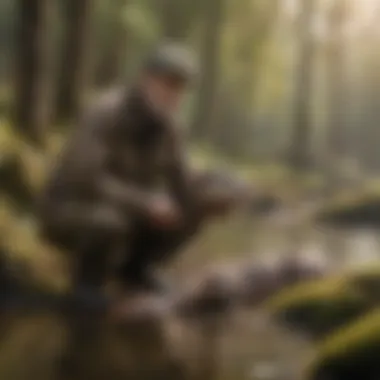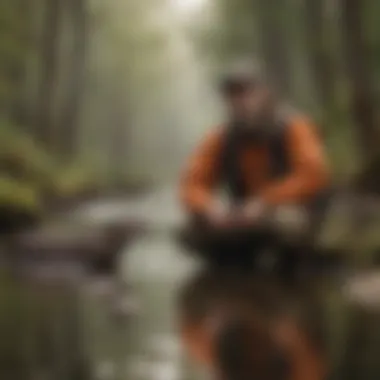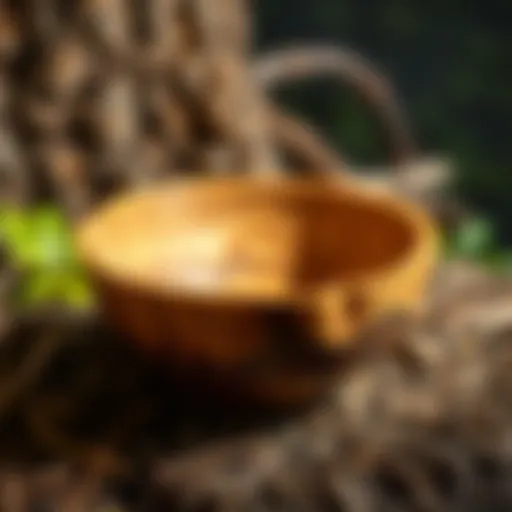Understanding Otter Traps: Options and Considerations


Intro
Otter trapping represents a unique intersection of wildlife management and legal regulation. Understanding the types of otter traps available, their intended functionality, and the ethical considerations involved is crucial for responsible trapping practices. The growing interest in managing otter populations highlights the need for clear guidance on how to approach trapping in a sustainable manner. This article aims to provide a comprehensive exploration of the options and considerations related to otter traps. By emphasizing the relevant methods and regulations, it will help both novice and experienced trappers navigate this complex terrain.
Overview of Otter Traps
Otter traps are specialized devices designed to capture otters humanely. There are several types available, each with its own set of features and operational principles. These traps function primarily to regulate otter populations, which can be significant in certain ecosystems. Understanding the differences among traps is essential for selecting the most suitable option for a given situation. Some common types include body-gripping traps, foothold traps, and cage traps.
Body-Gripping Traps
Body-gripping traps, also known as conibear traps, are designed to capture the animal by the body. These traps come in various sizes, depending on the target species. They can be set underwater or on land, making them versatile for otter trapping.
Foothold Traps
Foothold traps are designed to capture an otter by one foot. These traps can be set both underwater and on land as well. They allow for a more humane capture method, as the animal is not killed instantly but is restrained. However, it is important to check local regulations regarding the use of these traps.
Cage Traps
Cage traps provide a safe and humane way to capture otters without inflicting harm. They work by luring the otter into the trap with bait, where it is then confined until released. Although these traps may require more time and monitoring, they are often favored for their low impact on the animal.
Legal Regulations and Ethical Considerations
When considering otter trapping, understanding the legal framework is vital. Each region may have specific rules governing trapping seasons, permitted traps, and target species. Therefore, potential trappers must familiarize themselves with local laws prior to setting any traps. Failure to comply could result in fines or penalties.
The ethical implications of trapping cannot be overstated. It is essential that trappers employ methods that minimize suffering and ensure sustainable practices.
Ethical Trapping Practices
To ensure responsible trapping, consider the following:
- Education: Stay informed about local regulations and best practices in trapping.
- Humane Methods: Use traps designed to limit suffering and allow for non-target species to escape.
- Monitoring: Regularly check traps to minimize the time an animal is confined.
- Conservation Awareness: Be mindful of the ecological impact of trapping practices and strive for sustainable outcomes.
Best Practices for Selecting and Using Otter Traps
When choosing an otter trap, consider various factors, including the environment where the trap will be placed, the species being targeted, and the trap's effectiveness. The following tips can aid in making informed decisions:
- Research: Gather information on the types of traps available and their effectiveness in the local ecosystem.
- Test: If possible, evaluate different traps in various settings to determine which performs the best.
- Seek Expert Advice: Consult experienced trappers or wildlife management professionals for insights and recommendations.
A thorough understanding of otter traps, combined with knowledge of legal considerations and ethical practices, prepares trappers to engage in responsible wildlife management. This commitment helps to maintain healthy ecosystems while respecting the role of otters within them.
Prologue to Otter Traps
Otter traps are essential tools in managing otter populations and addressing conflicts between wildlife and human interests. Understanding otter traps involves examining both their function and the ethical dimensions surrounding their use. As otters often inhabit areas close to human activity, such as farms and water resources, their presence can lead to various complications. Trapping is one method of control, and it is important to use the right techniques and equipment to ensure effectiveness and compliance with regulations.
The study of otter traps encompasses various factors that potential users should consider. These include the types of traps available, their mechanisms, and any legal requirements that must be followed. A clear understanding of these elements can mean the difference between responsible trapping and illegal or ineffective practices. Additionally, knowledge of trap maintenance and ethical ramifications is critical for anyone involved in wildlife management.
The primary aim of this section is to lay the groundwork in comprehend the significance of using otter traps judiciously. Through informing readers about definitions, purposes, and broader implications, this discussion serves as a guide to those looking to engage in trapping. Not only is this important for the effectiveness of wildlife management strategies, it also ensures that such techniques contribute positively to conservation efforts.
Market Overview: Otter Traps for Sale
The market overview of otter traps plays a crucial role in informing prospective buyers about the available options. This section outlines the various types of traps on the market, their functionalities, and critical factors that should be evaluated before purchasing. Understanding these elements can streamline the decision-making process, ensuring that users select a trap that is most suited to their needs.
Types of Otter Traps
A well-informed choice is key in wildlife management, especially when selecting the appropriate type of trap. There are three main categories of otter traps: Live Traps, Conibear Traps, and Foot Hold Traps. Each has unique characteristics that cater to different trapping situations and user preferences.
Live Traps


Live traps are designed to capture otters without harming them. This non-lethal approach is important, particularly for those focused on conservation efforts. The key characteristic of live traps is their ability to capture the animal unharmed, allowing for relocation instead of termination. The unique feature of live traps is the use of a baited mechanism that entices otters to enter a designated space.
While live traps are often viewed favorably due to their animal-friendly design, they come with challenges, such as requiring regular checking to prevent stress or harm to the captured animal. Additionally, this method may not always be effective if otters are wary of unfamiliar objects in their habitat.
Conibear Traps
Conibear traps are a popular option among trapper for their efficiency. These traps are spring-loaded devices that quickly kill the otter upon capture, the key characteristic being their design that allows for a swift catch. As a result, they are considered a beneficial choice for those who prioritize quick results in control measures.
The unique feature of Conibear traps is their trigger mechanism that is activated when an otter swims through, making them effective in aquatic environments. With advantages such as minimal time to deploy and high capture success, these traps also raise ethical concerns. Critics argue that they can inadvertently harm non-target species, calling for mindful use and placement.
Foot Hold Traps
Foot hold traps function differently as they restrain the animal by one of its limbs rather than killing it. A key characteristic of foot hold traps is their adjustable design, accommodating animals of different sizes. They can be practical in situations where the objective is to capture rather than eliminate.
Although foot hold traps may seem like an ethical choice due to their non-lethal nature, they do have downsides. The unique feature revolves around the potential for injuries if the trap is not properly set or checked frequently. Moreover, there is the risk of attracting non-target species, which can lead to complications.
Key Features to Consider
When purchasing otter traps, several critical features must be analyzed to ensure effectiveness and suitability. Three main features to consider include Size and Material, Mechanism and Design, and Durability and Weather Resistance. Evaluating these features can significantly impact capturing success and user satisfaction.
Size and Material
The size and material of otter traps are vital for determining their effectiveness in various environments. The key characteristic here is that traps must be sufficiently sized to capture otters without causing them undue stress. Typically, heavier materials are used to withstand an otter’s strength.
Using high-quality materials can prevent rust and deterioration, making durable traps a wise investment. However, heavier traps may be more difficult to transport and handle, which can be a disadvantage for some users.
Mechanism and Design
A trap's mechanism and design are critical components affecting both user experience and animal welfare. The key characteristic of mechanisms must promote fast and effective capture. Depending on the trapping method employed, some designs allow for easier adjustments and re-baiting.
Choosing a trap with a simple design can aid in reducing the learning curve for novices, but this may come at the cost of trapping effectiveness. A more complex trap may provide superior results, but it could deter inexperienced users.
Durability and Weather Resistance
Durability and weather resistance are factors that ensure the longevity of the trap, particularly given its exposure to the elements. The key characteristic for durability is often found in the materials, which should be able to withstand wet and harsh conditions. While investing in a more durable trap might require a larger upfront cost, it can save money in the long run by reducing the need for replacements or repairs.
A lack of weather resistance can lead to rust and malfunctions, compromising the trap's effectiveness. Therefore, finding a balance between cost and quality is essential for both novice and experienced trappers.
Legal Regulations on Otter Trapping
The topic of legal regulations on otter trapping is crucial in understanding the role of trapping within wildlife management. Doing this correctly helps balance the needs of conservation with the demands of local ecosystems. Regulations vary significantly across regions, and everyone involved in otter trapping must be well-informed about these legalities to ensure that trapping efforts are compliant and ethical.
Understanding Local Laws
Local laws about otter trapping are affected by both state and federal regulations. Those considering otter trapping must familiarize themselves with the specific laws governing their area. These rules are designed to protect otter populations and ensure ecological integrity.
- Research Regional Regulations: Different regions may have unique rules concerning otter varieties, trapping techniques, and seasonality. Stay updated by consulting official wildlife agency websites or local government resources.
- Follow Seasonal Restrictions: Oftentimes, trapping seasons are strictly managed to prevent overharvesting during vulnerable periods of otter life cycles. This means not trapping during certain months or even having closed seasons.
- Check Protected Areas: Many regions have specially protected areas where trapping is entirely prohibited. Understanding these zones is critical to avoid legal trouble.
In general, early research can prevent misunderstandings and help ensure compliant trapping practices. A comprehensive understanding leads to sustainable trapping methods and helps maintain otter populations for future generations.
Permitting and Licensing Requirements
Permitting and licensing are essential components of responsible otter trapping. Engaging in trapping without the correct permits can lead to severe legal repercussions, including fines or confiscation of equipment. Here are some key aspects to consider:
- Obtain Necessary Licenses: In most jurisdictions, obtaining a specific trapping license is mandatory. Applications may require background checks or proof of trapping education.
- Understand Permit Types: Different permits may be available for various trapping purposes. Some are for recreational trapping, while others might be intended for managing nuisance animals.
- Proof of Competence: Authorities may require proof of training in humane trapping techniques as part of the application process.
- Compliance with Reporting Requirements: After trapping, successful trappers often need to report their catch, as this data aids in wildlife management.
Regions can vary widely in their requirements and processes. Ignorance is not an acceptable excuse; thus, thorough research is essential for anyone looking to trap legally and ethically. Understanding these aspects solidifies not only legality but also the ethical face of wildlife management.


Ethical Implications of Trapping
The ethical implications of trapping otters extend beyond simple legality and practicality. This topic raises essential questions about wildlife management, conservation strategies, and the responsibilities that come with the practice of trapping. In an era marked by heightened awareness of environmental sustainability and animal welfare, it becomes imperative for trappers and wildlife managers to navigate these waters carefully. Understanding the ethical aspects ensures that actions taken are not only effective but also justifiable under scrutiny.
Conservation vs. Control
At the heart of ethical trapping lies the duality of conservation versus control. On one side, trapping can play a crucial role in maintaining ecological balance. This is particularly important in areas where otter populations could adversely affect fish stocks or local ecosystems. Proponents argue that controlled trapping can prevent overpopulation, thereby protecting other species and preserving biodiversity.
However, the control aspect often raises ethical dilemmas. The act of trapping can be seen as a direct intervention in wildlife life. It is essential to carefully evaluate the ecological rationale behind trapping otters. Are there alternative measures that could achieve the same goals without the need for lethal methods? Assessing these factors can help determine if trapping is a necessary tool or an unethical approach to wildlife management.
Non-Target Species Considerations
Trapping otters brings forth concerns regarding non-target species. Traps designed for otters can unintentionally capture other animals. This bycatch can include various species, some of which may be endangered or protected. The ethical implications are significant. Capturing non-target species not only raises moral questions but can also lead to legal repercussions, depending on local wildlife laws.
To mitigate these risks, knowledgeable trappers should prioritize trap design that minimizes unintended captures. The use of selective traps, which are specifically geared towards otters, helps reduce bycatch. Additionally, educating practitioners about identifying and protecting local non-target species is crucial. Ethical trapping practices should include strategies for monitoring trap sites and regularly checking traps to minimize distress and suffering for captured animals.
"The use of traps should strive not only for efficiency in catching target species but also for humane treatment of all wildlife that may encounter them."
The ethical implications of otter trapping warrant serious consideration. By balancing conservation efforts with ethical practices, wildlife managers and trappers can ensure that their work contributes positively to the environment. Ultimately, a well-informed approach to trapping can harmonize the goals of wildlife management and ethical responsibility.
Best Practices for Otter Trapping
Best practices in otter trapping are crucial for achieving successful and responsible outcomes. These practices ensure that traps function effectively while adhering to ethical and legal standards. Most importantly, the methods employed can greatly influence the impact on otter populations and other wildlife. This segment outlines key considerations when engaging in otter trapping that can lead to optimal results.
Selecting the Right Trap for Your Needs
The selection of an appropriate trap is foundational when undertaking otter trapping. Different trap types serve distinct purposes.
- Live traps are often used for relocation efforts. They enable safe capture without harm, granting the opportunity to transfer otters to a more suitable habitat.
- Conibear traps are designed for efficiency. They quickly dispatch the target animal, but care must be taken to ensure they are set correctly to minimize unintended casualties.
- Foot hold traps allow for varied sizes and settings but come with a potential risk of injury to non-target animals.
To make an informed choice about traps, it is essential to consider the goals of trapping, local regulations, and the habitat. Researching the specific functionality of each trap type can ensure successful outcomes that align with responsible wildlife management.
Proper Placement and Setup
A knowledgeable approach to trap placement can significantly influence trapping success. Observing animal behavior and understanding their habitat will lead to more effective trapping.
Identifying Otter Habitats
Identifying otter habitats is a key element in any trapping endeavor. Otters tend to favor areas with abundant food sources, including rivers, lakes, and marshes. Recognizing these environments ensures that traps are set where they have a high likelihood of attracting otters. Furthermore, otters require shelter areas such as rocks or vegetation for breeding and safety.
Key characteristic: Otters are social animals often found in groups. Understanding their social structure aids in identifying the right habitats.
This habitat knowledge is beneficial as it increases the chances of successful captures. However, it can also require complex assessments of water quality and ecosystem health.
- Advantages: Increased likelihood of success, minimized disturbance to local ecology.
- Disadvantages: Requires time and effort in scouting and observing.
Strategic Trap Locations
Choosing strategic trap locations is vital for effective trapping. Observations of otter trails, signs of feeding, and movement patterns can guide placement. Setting traps near these paths can enhance the efficiency of capturing otters.
The key characteristic of strategic locations is proximity to water sources, where otters feel most comfortable. Selecting sites near natural bottlenecks, such as narrow river portions or under bridges, can also be effective.
- Advantages: Higher capture rates and reduced handling time.
- Disadvantages: Potential for trap interference from other wildlife or environmental factors.
Properly implementing these practices will facilitate a responsible and effective otter trapping experience that adheres to best practices, promoting conscientious wildlife management.
Maintenance and Care for Otter Traps


Maintaining otter traps is crucial. Regularly caring for traps ensures they function effectively and last longer. Traps that are not maintained can lead to ineffective results, resulting in wasted time, money, and potential harm to wildlife. When investing in otter traps, one must prioritize maintenance, as this affects overall trapping success and ethical standards.
The importance of regular maintenance involves a few key points. First, it enhances the efficacy of the traps. Keeping traps in top condition leads to better capture rates. Second, it fosters the humane treatment of the animals trapped. Poorly maintained traps can cause undue suffering to animals. Finally, well-cared traps contribute to user safety. A malfunctioning trap can pose a risk to humans and pets. Therefore, implementing a rigorous maintenance schedule is not just reasonable; it is essential.
Regular Inspections and Adjustments
Regular inspections of otter traps allow users to ensure all components function as intended. Going through traps after every use is a standard procedure. This process involves checking the trap’s spring mechanism, ensuring that it moves freely without obstruction. Adjustments may be necessary to align the trap correctly.
Key aspects to focus on during inspections include:
- Springs: Look for any signs of wear or damage. If springs are rusty, they may require replacement.
- Frame Integrity: Examine for bends or breaks, as even minor damages can affect overall performance.
- Trigger Mechanism: Ensure it is sensitive and responsive. An unresponsive trigger may lead to missed captures.
Adjustment of the trap’s tension may also be required over time. Each inspection should allow for minor tweaks that optimize performance. This diligence in inspection leads to better trapping outcomes.
Cleaning and Storage Practices
Cleaning otter traps is a responsible practice. After each use, it is important to clean traps to maintain their effectiveness. Buildup of dirt, vegetation, or debris can interfere with the lure and trap mechanisms. Clean traps will ensure that the user is stealthy and does not alarm potential captures.
Effective steps for cleaning include:
- Remove Debris: Trim any foliage or dirt that may have accumulated on the traps.
- Wash with Mild Detergent: Use a gentle cleaner to eliminate odors or residue. Chemical odors may deter otters from approaching.
- Dry Thoroughly: Ensure traps are fully dried before storage to prevent rust.
Proper storage practices also play a significant role. Traps should be stored in a dry, cool place to minimize exposure to moisture. A moisture-rich environment can provoke rust and deterioration. Securing traps in a plastic container or tote can offer additional protection from the elements.
"The longevity of your trapping equipment directly correlates to the thoroughness of your maintenance routine."
By understanding and implementing these maintenance and care strategies, trappers can improve their experience while adhering to the principles of responsible wildlife management.
Alternatives to Trapping
Exploring alternatives to trapping is essential for those involved in wildlife management, particularly otters. As professionals navigate the complex landscape of animal control, respecting ethical standards and environmental sustainability becomes paramount. Alternatives can help mitigate the risks associated with conventional trapping methods, offering practical solutions that prioritize animal welfare and ecological balance.
Relocation Methods
Relocation of otters involves identifying a safe, suitable habitat where these animals can thrive away from areas of human conflict. This method is often preferred due to its non-lethal approach. Here are some key considerations for effective relocation:
- Site Assessment: Before relocation, thoroughly assess potential sites to ensure they possess the necessary resources, such as water sources and food availability.
- Timing: The timing of relocation is crucial. Avoid winter months, as otters may struggle to acclimatize and find food in a new habitat.
- Legal Compliance: Ensure that relocation efforts comply with local laws and regulations regarding wildlife management. Obtaining necessary permits may be required.
The relocation method carries distinct benefits, including the preservation of animal populations and the fostering of human-wildlife coexistence. Nonetheless, it demands careful planning, as improper relocation can lead to significant stress for the animals involved.
Preventive Measures
Preventive measures can play a significant role in reducing human-wildlife conflicts without resorting to trapping. The implementation of effective strategies helps create environments that discourage otters from entering unwanted areas. Consider the following approaches:
- Exclusion Fencing: Installing fencing around vulnerable areas such as ponds or fish farms can help prevent otters from gaining access.
- Habitat Modification: Altering the environment can make it less appealing to otters. This might include removing food sources or covering openings to shelters.
- Community Education: Informing local communities about otter behavior and habitat needs fosters a better understanding and promotes coexistence.
The End
In the realm of wildlife management, the topic of otter trapping carries significant weight. Understanding the nuances of trapping methods, legal requirements, and ethical considerations is essential for any practitioner in the field. The importance of this discussion is underscored by the balance it aims to achieve between the need for population control and the imperative of responsible wildlife stewardship.
Summary of Key Points
This article has explored various dimensions of otter traps. Here are the main takeaways:
- Types of Traps: Different types of traps, including live traps, Conibear traps, and foot hold traps, serve distinct purposes and offer varying levels of humaneness and effectiveness.
- Legal Regulations: Awareness of local laws and the necessary permits are critical to ensure compliance and conserve otter populations.
- Ethical Implications: The conversation surrounding conservation versus control highlights the necessity for thoughtful practices that minimize harm to non-target species.
- Best Practices: Proper trap selection, placement, and maintenance are key to conducting effective and responsible trapping efforts.
- Alternatives to Trapping: Methods such as relocation and preventive measures may offer solutions that negate the need for trapping altogether.
Responsible Practices Moving Forward
To ensure sustainable management of otter populations, future practices must focus on ethics, legality, and environmental impact. Here are some important points to consider:
- Education: Continuous education about local wildlife and regulatory frameworks is essential. This enables better decision-making and adherence to best trapping practices.
- Community Involvement: Collaborating with local conservationists and employing community-based approaches can enhance awareness and support for ethical wildlife management.
- Reporting and Feedback: Engaging in discussions and feedback loops among practitioners can lead to improved techniques and shared learning which enhances the overall effectiveness in the field.
- Monitoring Populations: Regular monitoring of otter populations can provide insights that inform trapping practices and conservation efforts, ensuring that activities remain in balance with ecosystem needs.
In summary, the knowledge of otter traps, including their functionalities and the responsibilities that come with using them, is paramount to fostering a sustainable relationship with wildlife. Engaging with these practices thoughtfully will shape the future of otter management.







